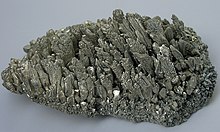Pidgeon process
[2] The Pidgeon processes in Canada in the year 2000 all used SF6 to cover the reaction so as not to introduce stray oxygen to it.
[1] The general reaction that occurs in the Pidgeon process is: For industrial use, ferrosilicon is used in place of pure silicon because its cheaper and more readily available.
The most used raw material is mined dolomite, a mixed (Ca,Mg)CO3, where the calcium oxide present in the reaction zone scavenges the silica formed, releasing heat and consuming one of the products, ultimately helping push the equilibrium to the right.
In the rotary kiln, the raw material, calcinated dolomite, is mixed with the finely ground reducing agent, ferrosillicone and the catalyst, fluorite.
A number of retorts are placed in a furnace in sealed paper bags to avoid moisture absorption so that calcined dolomite activity doesn't reduce magnesium yield.
[2] Canadian industry was tasked to discover a suitable alternative cover gas in order not to be sacrificed to Action Plan 2000 on Climate Change.
[5][11] The Pidgeon method is less technologically complex and because of distillation/vapour deposition conditions, a high purity product is easily achievable.
With the increased demand for magnesium in recent years, production through ore reduction has been emitting larger amounts of carbon dioxide and particulate matter.
[13][14][15] In China, production of magnesium using the Pidgeon process has a 60% higher global warming impact than aluminum, a competing metal mass-produced in the country as well.
[16] A few years later in 1939, when Canada and its allies entered WW2, they were short on supplies that required magnesium such as bombs, other military devices and aluminum alloys needed for aircraft.
Dr. Lloyd Montgomery Pidgeon at the National Research Council was able to create a method for extracting magnesium from dolomite in a vacuum at high temperature with ferrosilicon as the reducing agent.
[17] Since then, the Pidgeon process has continually been widely used, especially in China, the world's largest magnesium producer.




